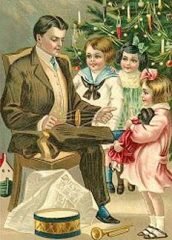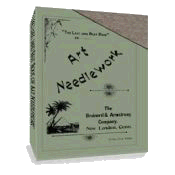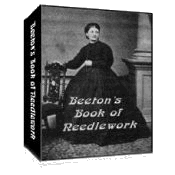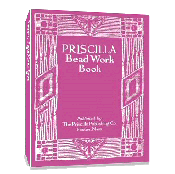[]Subscribe To This Site
Christmas History – An 1884 View
Much has been written on Christmas history… is December 25th the actual birth day of Jesus?, why that particular day was chosen?, etc. The following article is a view from a writer in 1884. I hope you find it as interesting as I did.

Christmas Festivities
Edited for use on this siteIt is not generally known — among the laity, that is — that for some hundreds of years after the birth of Christ, that birth, when celebrated at all, was celebrated nearly a fortnight later than the day we now observe, and that previously it was celebrated on dates much earlier in the year, as in May and June, apparently taken random, according to the fancy of the special ordainer of the feast to his church.
It was toward the close of the fourth century that St. CYRIL, of Jerusalem, received permission from the first Pope JULIUS for an investigation to be made, and the real day ascertained, if possible, on which JOSEPH and MARY rode up to Bethlehem to pay taxes. This, it was thought, might be done by an examination of the tables of the censors in the Roman archives. The result, however, was not entirely satisfactory; it was some time before the Eastern Church adopted the day decided upon, but at length the fathers, although not absolutely certain of its identification, resolved to accept the 25th of December, to which we have ever since adhered. Still, even at the present day, critical opinion is so far dissatisfied with the date as to be inclined to declare it rightfully some four or five days earlier than that from which we now count the Christian era.
By tradition the fact had already descended, and been accepted, that the birth took place at midnight; and the circumstance that between the middle of December and February there was a period of dry weather, separating the early and the latter rains in Palestine, made it possible that at such a season the shepherds might have been keeping their flocks upon the plains, and have seen the splendid vision recorded by the evangelist.
Probably what weighted quite as much as anything else was the early fathers in fixing the precise time was their knowledge that the winter solstice was regarded among most heathen people as the revival of dying nature, the turning of the sun on his path, to send renewed power through all the channels of the universe. Romans, Celts, and Germans had always held great feasts at this period, which was naturally one of spontaneous rejoicing, the Germans going so far as to believe that during the twelve nights now observed as the Christmas holidays they had evidence of the movement of their deities about the earth. And of course, the feast already existing, the fathers saw the wisdom of turning it to their own uses, as they did in the case of many other holidays. It was by means of their endeavor, however, to substitute their own festivities for the heathen ones that the old dramatic representations originated, the miracle plays, and manger songs; and the festivities always continued twelve days, and sometimes even to the beginning of the next month following.
The carols did not come into existence till the people had ceased easily to understand Latin. The songs of the Christmas-tide were emphasized by dancing, in which father and mother and children all took part on the night before Christmas, carrying lighted tapers in their hands, so occupying the hours between the three masses always celebrated on that night, and helped out by a collation, called the “reveillon,” which had its use in keeping them awake and fortifying them against fatigue.
It is form these early singers that the old legend comes that at midnight the dumb animals themselves do homage: “The cock crows out, ‘Christus natus est’ [Christ is born]; the ox bellows, ‘Ubi?’ [where?] and falls on his knees; the lamb bleats, ‘Bethlehem;’ the ass brays, ‘Eamus’ [let us go], and the bees hum the Hundredth Psalm.”

All the general saturnalia of Christmas, which finally enlarged its bounds into games under the control of the Lord of Misrule, the Abbot of Unreason, and the Captain of all Mischief, were known as the December Liberties, and we dare say there was many a good house-mother among the early Christians, as among the later ones, who was glad when it was all well over, if the consequences of free use of the wassail bowl, with its compound of brown ale, sugar, spice, toast, and roasted apples, the “gossip bowl” of SHAKSPEARE’S Midsummer Night were really ever well over with the end of the Liberties, and did not leave many a sore stomach and aching head in memory of the day marked on the old Scandinavian calendar of the clog-almanac with a drinking horn.
Indeed, in the days of the height of Christmas merry-making in Old England, the house-mother, who loved to have all things done decently and in order, might well have remembered the superstition regarding Northern people, which held that in the twelve days succeeding Christmas they were turned into wolves, and let loose among men not thus metamorphosed, and were then as much worse than ordinary wolves as when men they had been superior.
We have left all this wild merriment of our forefathers, who must need spend on something that animal vigor and excess of vitality which we expend in the pursuit of wealth, in our inventions and our applications of science, in our tunneling of mountains and building of bridges and laying of cables, an d in our exploring expeditions to the uttermost parts of the earth, followed by those for the relief of the explorers. Thus Christmas-keeping has sobered down into a simple matter of family reunion, into the hanging of stockings, the laying out of little sabots, the decking of trees for children; into the interchange of gifts and the eating of a good dinner; and as we grow older with each year losing a little of its merry-making quality, and taking on some of the sadness following those changes made evident by recurring anniversaries, in spite of all religious joy. We have come to realize that we ourselves, at any rate, are no longer children, but are gown people in a world where there is much more than playing o do, and the realization makes us more reasonable in our enjoyment than those that went before us as late as two hundred years ago, even when we make the day a particularly festive one.
Nevertheless, reasonable or not, we do not fail, in the mass, to keep the season in some way, glad to acknowledge all that has been done for us by the day it stands for, and without too much solicitude as to whether we have the precise and particular time, remembering that at whatever season it has been or may be celebrated, at the summer or the winter solstice, it is not the accident of date that we commemorate, but the profound and mighty fact of the salvation of a race by means of that for which we celebrate the day at all.
Return to top of Christmas History page.
Return to Victorian Christmas page.
Return to Home page.



 433 pages!
433 pages!

